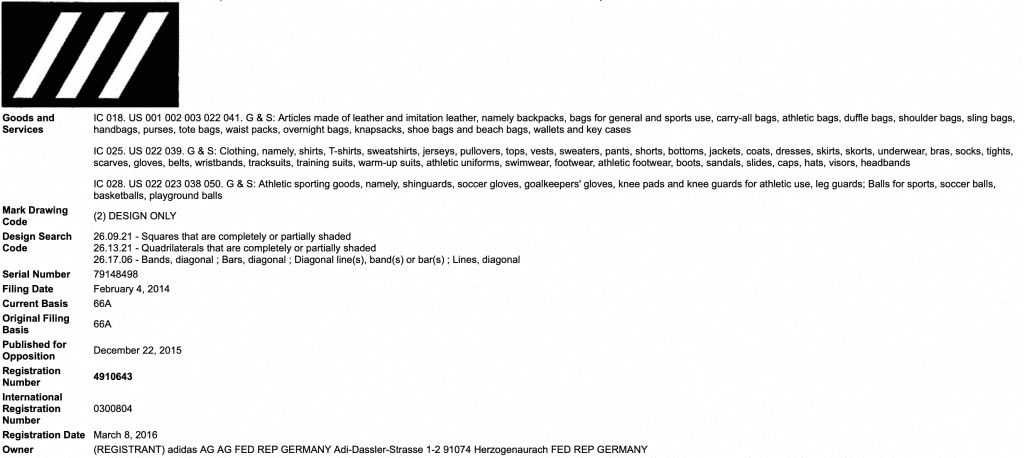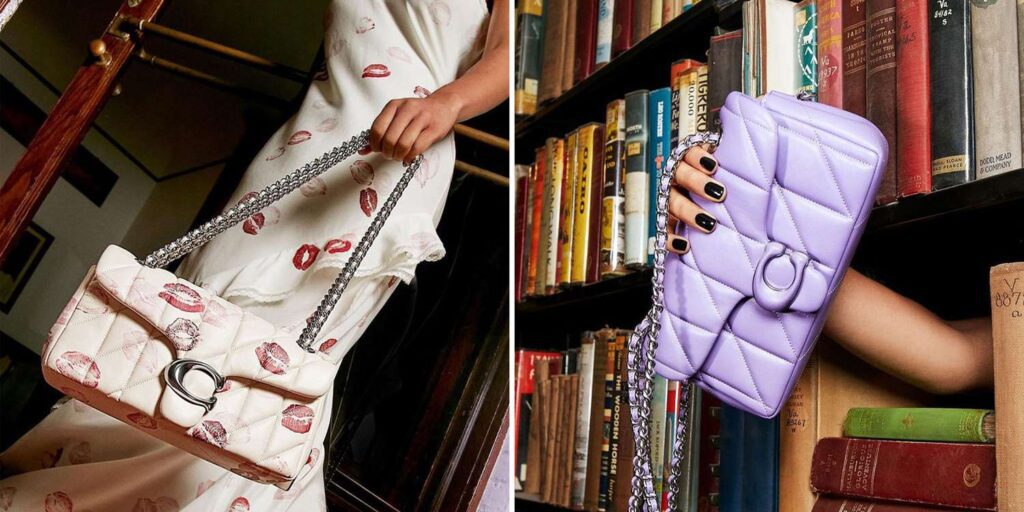Adidas has fired back in response to Thom Browne’s attempt to get one of its 3-stripe trademark registrations cancelled, arguing that the fashion brand’s cancellation counterclaim falls short. In a newly-filed motion to dismiss Thom Browne’s counterclaim and strike three of its affirmative defenses, adidas asserts that while Thom Browne is pushing to get the registration for its “Three-Quadrilaterals Design” mark cancelled on the basis that it is aesthetically functional, Thom Browne fails to allege that “the particular iteration” of adidas’s famous 3-stripe mark is, in fact, aesthetically functional, and instead, alleges that “any ‘parallel stripes’ design is aesthetically functional.”
For some background, adidas asserts in its June 9 motion and corresponding memo in support that it owns “no fewer than 23 federal trademark registrations covering the 3-stripe mark as applied to apparel, footwear, and various other products,” and among those registrations is one for its “Three-Quadrilaterals Design” (No. 4,910,643), which extends to a particular iteration of the 3-stripe mark for clothing, footwear, and other goods, and which adidas cites against Thom Browne in its infringement and dilution complaint.
In an effort to skirt infringement liability in the lawsuit that adidas initiated against it back in June 2021 (in which adidas argues that Thom Browne’s use of 3- and 4-stripe designs on athletic apparel and footwear infringes its federally-registered 3-stripe mark), Thom Browne seeks cancellation of the “Three-Quadrilaterals Design.” Citing the Second Circuit’s 2012 decision in Christian Louboutin S.A. v. Yves Saint Laurent Am. Holdings, Inc., New York-based Thom Browne argues that the court should invalidate the registration on the basis of aesthetic functionality, under which, a mark is ineligible for trademark protection “if granting the owner the exclusive right to use the mark ‘would put competitors at a significant non-reputation related disadvantage.’”

The problem with this, according to adidas, is that Thom Browne fails to make sufficient factual allegations that the “Three-Quadrilaterals Design” mark is aesthetically functional, asserting merely that: “(1) Because adidas alleges that Thom Browne’s use of certain 4-stripe designs on athletic clothing infringes adidas’s 3-stripe mark, adidas purportedly ‘admits’ that its trademark rights exceed what is depicted in the challenged registration; (2) Third parties use stripes ‘in a wide variety of orientations, numbers and placements on clothing, including in a diagonal orientation and/or parallel to one another;’ and (3) If clothing designers were not permitted to use parallel stripes on clothing, they would be put to a significant non-reputation related disadvantage.”
Even taken as true, these allegations “do not plausibly support” an aesthetic functionality counterclaim, per adidas, “because they concern competitors’ purported need to use ‘parallel stripes on clothing,’ not the 3-stripe mark (much less the particular iteration of the 3-stripe mark covered by the challenged registration).” Specifically, adidas argues that Thom Browne “does not allege that protection of the 3-stripe mark would put competitors at a significant disadvantage, much less that the particular iteration reflected in the challenged registration would put competitors at a significant disadvantage.” Instead, Thom Browne references “the broad category of any number of ‘parallel stripes’ and then argues that protection of ‘parallel stripes on clothing’ in general would put competitors at a disadvantage.” Thom Browne “departs even further from the actual mark at issue,” adidas claims, “by alleging that ‘third party clothing designers use stripes in a wide variety of orientations, numbers and placements on clothing.’”
Ultimately, adidas contends that Thom Browne’s counterclaim alleges that “an unspecified number and orientation of ‘parallel stripes’ is aesthetically functional,” and thus, does not actually allege that the 3-stripe mark, including the particular “Three-Quadrilaterals Design” iteration, is aesthetically functional, resulting in its counterclaim failing as a matter of law.
Beyond that, Thom Browne “also fails to allege facts plausibly showing that protection of the 3-stripe mark (e.g., three parallel stripes) would put adidas’s competitors at a significant, non-reputation-related disadvantage,” the German sportswear brand argues. At most, it claims that Thom Browne alleges that “third party clothing designers use stripes in a wide variety of orientations, numbers and placements on clothing,” and that “if clothing designers were not permitted to use parallel stripes on clothing, they would be put to a significant, non-reputation related disadvantage.”
Thom Browne’s “fail[ure] to allege facts showing what disadvantage these designers would suffer, nor why it is ‘significant,’” is an alternative reason why its cancellation counterclaim should be dismissed, per adidas.
For the same reasons, adidas states that Thom Browne’s aesthetic functionality affirmative defense should be dismissed, as should its laches, estoppel, and acquiescence (on the basis that Browne “fails to allege that it has been prejudiced by adidas’s purported conduct”) and unjust enrichment defenses.
The lawsuit comes as adidas argues that Thom Browne has moved into the hyper-competitive sportswear market, “encroaching into direct competition with adidas by offering sportswear and athletic-styled footwear that bear confusingly similar imitations of adidas’s 3-stripe mark” despite making its name by way of “tailored and cropped men’s suits and jackets and avant-garde womenswear.” Adidas alleges that such encroachment into its “core market category” has been exacerbated by Thom Browne’s “partnership with the famous European football (soccer) club FC Barcelona, beginning with the 2018-2019 season and continuing today,” in connection with which Thom Browne “has promoted its goods using images associated with soccer and even several soccer players that are sponsored by adidas.”
The case is adidas America, Inc., et al., v. Thom Browne, Inc., 1:21-cv-05615 (SDNY).











